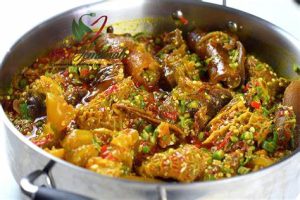
Oha soup is a beloved dish that holds deep cultural significance in Eastern Nigeria, particularly among the Igbo people. Known for its rich, flavourful broth and tender Oha leaves, this traditional soup is a staple at family gatherings, celebrations, and everyday meals. The richness of Oha soup lies not only in its complex blend of ingredients but also in its historical and regional importance, making it a dish that truly represents the heart of Eastern Nigerian cuisine.
A Cultural Icon in Eastern Nigeria
Oha soup is much more than a delicious meal; it is a cultural icon in Eastern Nigeria. The soup, made primarily with Oha leaves (Pterocarpus mildbraedii), is indigenous to the Igbo people, who have been preparing and passing down this recipe through generations. The Eastern roots of Oha soup have cemented its place in the culinary traditions of the region, where it is often prepared for important occasions such as weddings, festivals, and naming ceremonies.
The preparation of Oha soup is frequently viewed as an art form, as the cook must balance the flavours of the various ingredients to create a harmonious dish. The soup combines the unique taste of the leaves with a base of thickened palm oil, meats, and seasoning, offering a rich and filling experience.
Ingredients That Make Oha Soup Unique
The key to the richness of Oha soup lies in its ingredients. Oha leaves are the star of the dish, providing a subtle, earthy flavor and a texture that softens beautifully when cooked. Unlike other green vegetables used in Nigerian soups, Oha leaves are not pounded or crushed; instead, they are carefully shredded by hand to preserve their tender nature.
Other essential ingredients that add to the richness of Oha soup include:
- Palm oil: This ingredient gives the soup its vibrant orange colour and adds a deep, earthy flavor.
- Thickening agents: Coco-yam paste is traditionally used to thicken the soup, creating a hearty and creamy consistency.
- Meats: Oha soup is typically cooked with a variety of meats, such as goat, beef, or chicken, and sometimes even assorted meats like cow tripe or snails.
- Seasonings: A blend of spices, including ground crayfish, dried fish, and seasoning cubes, enhances the soup’s savoury depth.
- Ogiri: This fermented oilseed paste adds a bold, pungent flavor, contributing to the soup’s overall complexity.
The Preparation Process
Preparing Oha soup involves a delicate process that combines both tradition and technique. The first step is to prepare the thickening agent by boiling and pounding coco-yam. This creates the creamy base for the soup, into which palm oil and seasonings are added. The meats are then introduced, allowing them to simmer until tender.
Once the base and meats are ready, the Oha leaves are added toward the end of the cooking process to avoid overcooking and maintain their freshness. The result is a rich, savoury soup that bursts with the flavours of its ingredients, while the tender leaves provide a perfect contrast to the hearty meats and thickened broth.
The Significance of Oha Soup in Igbo Culture
The richness of Oha soup extends beyond its taste; it also holds deep significance in Igbo culture. In many families, the preparation and sharing of Oha soup symbolize unity and tradition. It is often reserved for special occasions, where it is shared as a gesture of love and hospitality. For the Igbo people, preparing this soup for guests or family members is a way of honouring relationships and preserving cultural heritage.
Oha soup is also considered a symbol of abundance, as the ingredients used—such as meats, coco-yam, and palm oil, are associated with wealth and prosperity in Eastern Nigeria. Its presence at events regularly signifies celebration and communal enjoyment.
The Lasting Impact of Oha Soup on Nigerian Cuisine
Oha soup continues to be one of the most cherished dishes in Nigerian cuisine, representing the essence of traditional cooking from the Eastern part of the country. Its richness, in terms of both flavor and cultural importance, has solidified its place in the hearts of many Nigerians. As more people discover the versatility and taste of this traditional soup, it remains a symbol of the enduring connection between food, culture, and family in Nigeria.
Discover more from Amebo Media
Subscribe now to keep reading and get access to the full archive.




